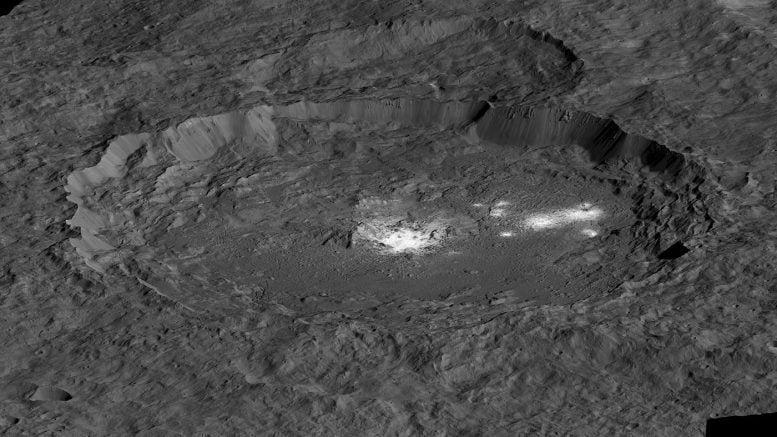
The bright areas of Occator Crater — Cerealia Facula in the center and Vinalia Faculae to the side — are examples of bright material found on crater floors on Ceres. This is a simulated perspective view. Credit: NASA/JPL-Caltech/UCLA/MPS/DLR/IDA/PSI
If you could fly aboard NASA’s Dawn spacecraft, the surface of dwarf planet Ceres would generally look quite dark, but with notable exceptions. These exceptions are the hundreds of bright areas that stand out in images Dawn has returned. Now, scientists have a better sense of how these reflective areas formed and changed over time — processes indicative of an active, evolving world.
“The mysterious bright spots on Ceres, which have captivated both the Dawn science team and the public, reveal evidence of Ceres’ past subsurface ocean, and indicate that, far from being a dead world, Ceres is surprisingly active. Geological processes created these bright areas and may still be changing the face of Ceres today,” said Carol Raymond, deputy principal investigator of the Dawn mission, based at NASA’s Jet Propulsion Laboratory in Pasadena, California. Raymond and colleagues presented the latest results about the bright areas at the American Geophysical Union meeting in New Orleans on Tuesday, December 12.
Different Kinds of Bright Areas
Since Dawn arrived in orbit at Ceres in March 2015, scientists have located more than 300 bright areas on Ceres. A new study in the journal Icarus, led by Nathan Stein, a doctoral researcher at Caltech in Pasadena, California, divides Ceres’ features into four categories.
The first group of bright spots contains the most reflective material on Ceres, which is found on crater floors. The most iconic examples are in Occator Crater, which hosts two prominent bright areas. Cerealia Facula, in the center of the crater, consists of bright material covering a 6-mile-wide (10-kilometer-wide) pit, within which sits a small dome. East of the center is a collection of slightly less reflective and more diffuse features called Vinalia Faculae. All the bright material in Occator Crater is made of salt-rich material, which was likely once mixed in water. Although Cerealia Facula is the brightest area on all of Ceres, it would resemble dirty snow to the human eye.
More than 300 bright spots have been located on the surface of Ceres. Scientists with NASA’s Dawn mission say the bright material indicates the dwarf planet is an active, evolving world.
More commonly, in the second category, bright material is found on the rims of craters, streaking down toward the floors. Impacting bodies likely exposed bright material that was already in the subsurface or had formed in a previous impact event.
Separately, in the third category, bright material can be found in the material ejected when craters were formed.
The mountain Ahuna Mons gets its own fourth category — the one instance on Ceres where bright material is unaffiliated with any impact crater. This likely cryovolcano, a volcano formed by the gradual accumulation of thick, slowly flowing icy materials, has prominent bright streaks on its flanks.
Over hundreds of millions of years, bright material has mixed with the dark material that forms the bulk of Ceres’ surface, as well as debris ejected during impacts. That means billions of years ago, when Ceres experienced more impacts, the dwarf planet’s surface likely would have been peppered with thousands of bright areas.
“Previous research has shown that the bright material is made of salts, and we think subsurface fluid activity transported it to the surface to form some of the bright spots,” Stein said.
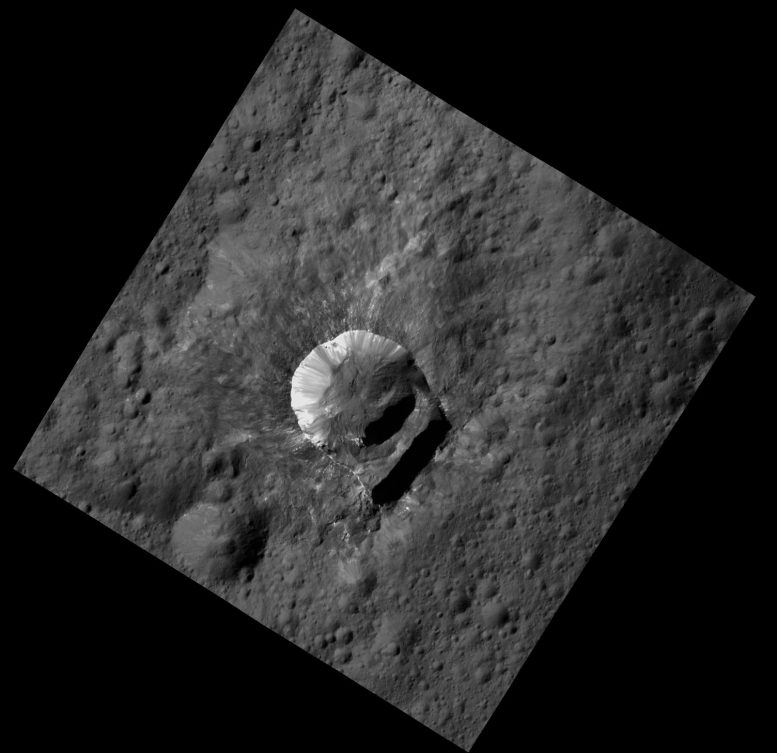
Oxo Crater is unique because of the relatively large “slump” in its crater rim. Credit: NASA/JPL-Caltech/UCLA/MPS/DLR/IDA/PSI
The Case of Occator
Why do the different bright areas of Occator seem so distinct from one another? Lynnae Quick, a planetary geologist at the Smithsonian Institution in Washington, has been delving into this question.
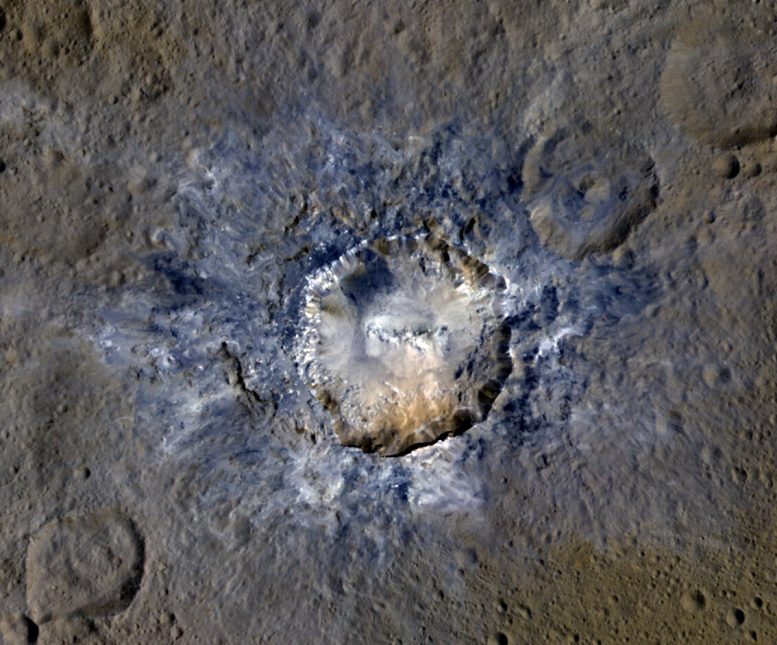
Ceres’ Haulani Crater, with a diameter of 21 miles (34 kilometers), shows evidence of landslides from its crater rim. Credit: NASA/JPL-Caltech/UCLA/MPS/DLR/IDA
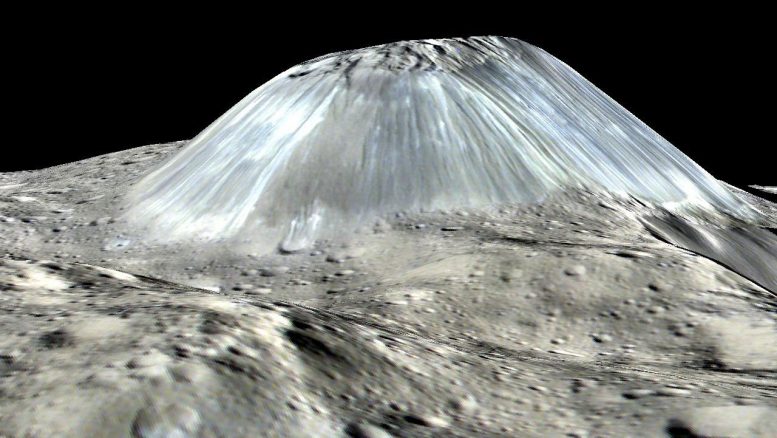
Ceres’ lonely mountain, Ahuna Mons, is seen in this simulated perspective view. The elevation has been exaggerated by a factor of two. The view was made using enhanced-color images from NASA’s Dawn spacecraft. Credit: NASA/JPL-Caltech/UCLA/MPS/DLR/IDA
The leading explanation for what happened at Occator is that it could have had, at least in the recent past, a reservoir of salty water beneath it. Vinalia Faculae, the diffuse bright regions to the northeast of the crater’s central dome, could have formed from a fluid driven to the surface by a small amount of gas, similar to champagne surging out of its bottle when the cork is removed.
In the case of the Vinalia Faculae, the dissolved gas could have been a volatile substance such as water vapor, carbon dioxide, methane or ammonia. Volatile-rich salty water could have been brought close to Ceres’ surface through fractures that connected to the briny reservoir beneath Occator. The lower pressure at Ceres’ surface would have caused the fluid to boil off as a vapor. Where fractures reached the surface, this vapor could escape energetically, carrying with it ice and salt particles and depositing them on the surface.
Cerealia Facula must have formed in a somewhat different process, given that it is more elevated and brighter than Vinalia Faculae. The material at Cerealia may have been more like an icy lava, seeping up through the fractures and swelling into a dome. Intermittent phases of boiling, similar to what happened when Vinalia Faculae formed, may have occurred during this process, littering the surface with ice and salt particles that formed the Cerealia bright spot.
Quick’s analyses do not depend on the initial impact that formed Occator. However, the current thinking among Dawn scientists is that when a large body slammed into Ceres, excavating the 57-mile-wide (92-kilometer-wide) crater, the impact may have also created fractures through which liquid later emerged.
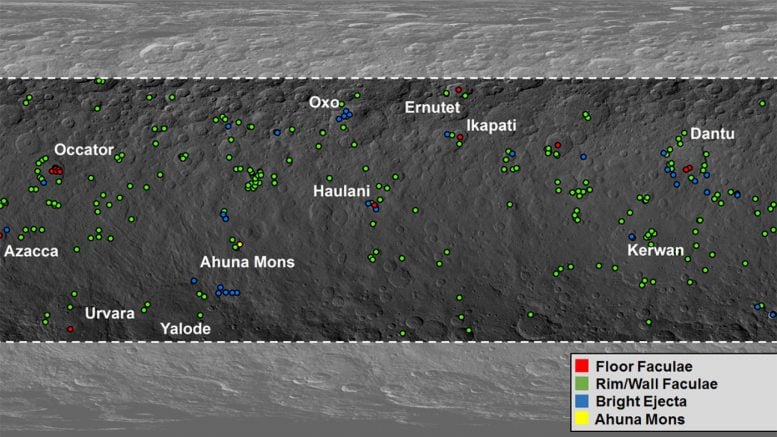
This map from NASA’s Dawn mission shows locations of bright material on dwarf planet Ceres. There are more than 300 bright areas, called “faculae,” on Ceres. Credit: NASA/JPL-Caltech/UCLA/MPS/DLR/IDA/PSI/Caltech
“We also see fractures on other solar system bodies, such as Jupiter’s icy moon Europa,” Quick said. “The fractures on Europa are more widespread than the fractures we see at Occator. However, processes related to liquid reservoirs that might exist beneath Europa’s cracks today could be used as a comparison for what may have happened at Occator in the past.”
As Dawn continues the final phase of its mission, in which it will descend to lower altitudes than ever before, scientists will continue learning about the origins of the bright material on Ceres and what gave rise to the enigmatic features in Occator.
Reference: A. Nathues, et al., “Occator Crater in Color at Highest Spatial Resolution” by A. Nathues, T. Platz, G. Thangjam, M. Hoffmann, J.E.C. Scully, N. Stein, O. Ruesch, K. Mengel, 13 December 2017, Icarus.
DOI: 10.1016/j.icarus.2017.12.021

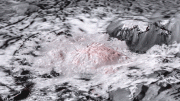
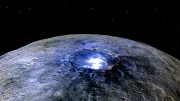
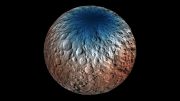
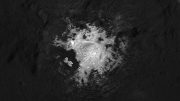
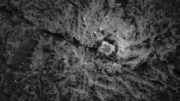
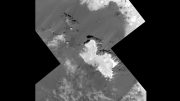
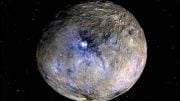
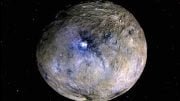
Be the first to comment on "Mysterious Bright Spots Suggest Geologic Activity on Ceres"